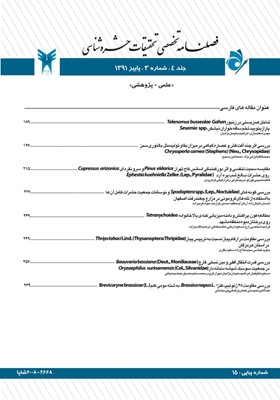بررسی مقاومت 48 ژنوتیپ کلزا .Brassica napus L به شته مومی کلم Brevicoryne brassicae (L.)
محورهای موضوعی : حشره شناسی و سایر بندپایانعبدالامیر محیسنی 1 , عباس ترکمانی پیرمیشانی 2
1 - مرکز تحقیقات کشاورزی و منابع طبیعی لرستان، ایستگاه تحقیقات کشاورزی و منابع طبیعی بروجرد
2 - مرکز تحقیقات کشاورزی و منابع طبیعی لرستان، ایستگاه تحقیقات کشاورزی و منابع طبیعی بروجرد
کلید واژه: Resistance, Borujerd, مقاومت, ژنوتیپ, Brassica napus, Genotypes, کلـزا, Brevicoryne brassicae, شته Brevicoryne brassicae,
چکیده مقاله :
علیرغم تلاشهای گستردهای که در سراسر دنیا برای کنترل شته مومی کلم Brevicoryne brassicae (L.) صورت میگیرد، این آفت هنوز یکی از مهمترین آفات گیاهان خانواده Brassicaceae میباشد. این تحقیق طی سالهای 1381-1382 به منظور بررسی وجود مقاومت در 48 ژنوتیپ کلزا به شته مومی کلم Brevicoryne brassicae (L.) در ایستگاه تحقیقات کشاورزی بروجرد اجرا گردید. در سال اول تعداد هشت ژنوتیپ نسبت به شته مومی مقاومت نسبی نشان دادند که در سال دوم این ژنوتیپ ها همراه با ژنوتیپ حساس VDH8003/98 در شرایط زراعی و آزمایشگاهی مورد بررسی قرار گرفتند. در شرایط مزرعهای دو آزمایش مشابه و جداگانه (سمپاشیشده و سمپاشینشده) در قالب طرح بلوکهای کامل تصادفی با چهار تکرار انجام گرفت. نتایج نشان داد که بیشترین و کمترین شاخص آلودگی و نرخ ذاتی رشد جمعیت (rm) به ترتیب مربوط به دو ژنوتیپ VDH8003/98 و PF7045/91 بود. بر اساس مطالعات آزمایشگاهی و مزرعهای، از میان 48 ژنوتیپ مورد آزمایش، VDH8003/98 حساسترین و PF7045/91 مقاومترین ژنوتیپها نسبت به شته مومی کلم بوده و بقیه ژنوتیپها در بین این دو گروه قرار میگیرند.
The cabbage aphid, Brevicoryne brassicae (L.), has been remained one of the most important pests of horticultural and oil-seed Brassica crops, despite all attempts to control its infestation. This research was conducted to evaluate the resistance of 48 rapeseed (Brassica napusL.) genotypes to cabbage aphid, Brevicoryne brassicae (L.) at Borujerd agricultural research station, Iran. during 2001-2003. In the first year, out of 48 genotrypes 8 showed a moderately resistance in comparison to rest. In the second year these 8 geotypes and a susceptible one (VDH8003/98) were evaluated in the field and laboratory condition. In the field condition, two similar but separated trials (treatment with insecticide and no treatment) were done in a randomized complete block design with four replications. Results showed that the most and the least infestation index and rm (intrinsic rate of natural increase) belonged to VDH 8003/98 and PF7045/91 respectively. Based on the field and laboratory investigations, among 48 genotypes, the most susceptible was VDH 8003/98 and the most resistant one was PF7045/91 and the other varieties were placed between these two.


